Face-to-Face and Blended: Two Pedagogical Conditions for Testing the Efficacy of the Culturo-Techno-Contextual Approach on Learning Anxiety and Achievement in Chemistry
Abstract
1. Introduction
1.1. Students’ Performance in Chemistry
1.2. Anxiety and Chemistry Learning
1.3. Gender Difference in Achievement in Chemistry
1.4. Purpose and Research Questions
- Is there a statistical difference in the achievement and anxiety level of secondary school students in electrochemistry when taught using CTCA in a face-to-face class; blended class; and using the conventional lecture method?
- Is there a statistical difference in the achievement and anxiety levels of male and female students taught electrochemistry using CTCA in the face-to-face class and blended class?
- What perception do secondary school students hold about the use of CTCA as a strategy for teaching and learning chemistry?
1.5. Why the Culturo-Techno-Contextual Approach?
1.6. The Blended Learning Mode
1.7. Theoretical Perspective
1.8. What Informed Our Choice of Electrochemistry?
2. Methodology
2.1. Participants
2.2. Instruments
- If a current of 4.5A is passed through a solution of silver salt for 75 min, what is the mass of silver deposited? (A) 22.66 g; (B) 31.45 g (C) 28.16 g; (D) 33.65 g
- When dilute copper(II)chloride solution is electrolysed, the reaction at the cathode is represented by which of these equations?
- The set-up of an electroplating experiment is a typical example of (A) a chemical cell; (B) an electrolytic cell; (C) a Daniel cell; (D) a Leclanche cell.
- Whenever it is time to learn chemistry, I feel excited. Yes or No.
- Whenever it is time to learn chemistry, I feel scared. Yes or No.
2.3. Procedures for Implementing CTCA
2.4. Data Gathering and Analyses
3. Results
4. Discussion of Results
4.1. Effects of CTCA on Students’ Achievement (Retention) in Electrochemistry
Nasir (pseudo name; 15 years; male; face-to-face group) said the following: Having to make findings about a new topic before by going on online to watch videos and ask my parents for indigenous knowledge related to the topic gave me a whole lot of courage when I get to class to answer questions. I found the indigenous knowledge to be the most interesting and helpful part. In the sense that it helped me to relate what we learn in class to rea life experience it also help me to know what those things stand for and their usefulness. Being a member of a group was very interesting, I get to learn from my friends and also represent them as a group leader, it gives courage and also brings about competition in class because you want to present better than other groups. The group activity create excitement in class and the class was always interesting.
Adaobi (pseudo name; 14 years; female; blended group) had the following to say: For me, I like going to the YouTube and I enjoy everything that I do there. I like diagrams, videos, I find them very interesting, so I enjoy that part of the class. The indigenous knowledges and interacting with people are also a nice one. It makes me to know how things around me works.
Nneka (pseudo name; 15 years; female; online group) said: Going online and asking my parents about every lesson before the class aided my understanding of the topics because it usually give me a preview of what the topics we are about learn, it makes me understand the topics better. The part of the method that I find most interesting is the indigenous part. Going to find about the cultural aspect on the topics, the local practices. Particularly my findings on electroplating.
4.2. Effects of CTCA on Students’ Anxiety Level in Learning Chemistry
“Ordinarily, most students do not visit YouTube to watch video lessons of topics learned in school. The greater attraction for them being musical and entertainment movies. Sadly, some venture into pornographic videos. Since these students already have some appetite for YouTube and technical expertise for retrieving and watching its videos, the idea in CTCA is to ride on the back of such interest and steer the students towards watching lesson-related videos” (Okebukola, 2020).
4.3. Effect of CTCA on Students’ Achievement (Retention) and Anxiety Levels Based on Gender
“We are a visually literate society, three R’s (read, write and arithmetic) are no longer enough. Our world is changing fast, faster than we can keep up with our historical modes of thinking and communicating. Visual literacy the ability to both read and write visual information; the ability to learn visually; to think and solve problems in the visual domain will, as the information revolution evolves, become a requirement for success in business and in life”. Gray (nd).
5. Conclusions
Limitation and Future Direction
Author Contributions
Funding
Institutional Review Board Statement
Informed Consent Statement
Data Availability Statement
Acknowledgments
Conflicts of Interest
References
- Oladejo, A.I.; Nwaboku, N.C.; Okebukola, P.A.; Ademola, I.A. Gender difference in students’ performance in chemistry–can computer simulation bridge the gap? Res. Sci. Technol. Educ. 2021, 1–20. [Google Scholar] [CrossRef]
- Onowugbeda, F.U.; Okebukola, P.A.; Agbanimu, D.O.; Ajayi, O.A.; Oladejo, A.I.; Awaah, F.; Ademola, I.A.; Gbeleyi, O.A.; Peter, E.O.; Ige, A.M. Can the culturo-techno-contextual approach (CTCA) promote students’ meaningful learning of concepts in variation and evolution? Res. Sci. Technol. Educ. 2022, 1–17. [Google Scholar] [CrossRef]
- Nzewi, U.M. Recent Developments in Gender Issues in STEM Education. YouTube. 2020. Available online: https://youtu.be/mcbpmMgjis4 (accessed on 22 October 2021).
- Ademola, I.A.; Oladejo, A.I.; Gbeleyi, O.A.; Onowugbeda, F.U.; Owolabi, O.L.; Okebukola, P.A.; Agbanimu, D.O.; Uhuegbu, S.I. Impact of Culturo-Techno-Contextual Approach (CTCA) on Learning Retention: A Study on Nuclear Chemistry. J. Chem. Educ. 2023, 100, 581–588. [Google Scholar] [CrossRef]
- Okebukola, P.A.O. Breaking Barriers to Learning of Science: The CTC Approach; Sterling Press: Slough, UK, 2020. [Google Scholar]
- Obikezie, M.C.; Chikendu, R.E. Effect of Cooperative Group Learning Strategy on Secondary School Students’ Achievement in Chemistry in Anambra State, Nigeria. Int. J. Adv. Eng. Manag. 2021, 3, 275–283. [Google Scholar]
- Oludipe, D.I. Gender difference in Nigerian junior secondary students’ academic achievement in basic science. J. Educ. Soc. Res. 2012, 2, 93–99. [Google Scholar]
- Adesope, O.O.; Nesbit, J.C. Animated and static concept maps enhance learning from spoken narration. Learn. Instr. 2013, 27, 1–10. [Google Scholar] [CrossRef]
- Gongden, E.J.; John, D.P.; Gimba, E.M. Effects of Jigsaw Cooperative Learning Strategy on Senior Secondary Two Chemistry Students’ Understanding of Chemical Kinetics in Jos South LGA of Plateau State, Nigeria. 2019. Available online: http://hdl.handle.net/123456789/3270 (accessed on 22 October 2021).
- Amponsah, K.D.; Kotoka, J.K.; Beccles, C.; Dlamini, S.N. Effectiveness of Collaboration on Low and High Achieving School Students’ Comprehension of Electrochemistry in South Africa. Eur. J. STEM Educ. 2018, 3, 4. [Google Scholar] [CrossRef]
- Okwuduba, E.N.; Okigbo, E.C. Effect of Teaching Methods on Students’ Academic Performance in Chemistry in Nigeria: Meta-Analytic Review. Bulg. J. Sci. Educ. Policy 2018, 12, 418–434. [Google Scholar]
- Jabeen, F.; Afzal, M.T. Effect of Simulated Chemistry Practicals on Students’ Performance at Secondary School Level. J. Educ. Educ. Dev. 2020, 7, 119–139. [Google Scholar] [CrossRef]
- Ogunleye, B.O. Effects of concrete-representational-abstract instructional strategy on chemistry performance of students with mathematics learning difficulties in Ogun State, Nigeria. KIU J. Educ. 2019, 14, 135–151. [Google Scholar]
- Udu, D.A. Comparative effects of individualised and cooperative learning instructional strategies on senior secondary school students’ academic achievement in organic chemistry. Electron. J. Res. Sci. Math. Educ. 2018, 22, 1–14. [Google Scholar]
- Omoniyi, A.O.; Torru, T.E. Effectiveness of Process Oriented Guided Inquiry Teaching Strategy on Students’ Performance in Chemistry in Secondary Schools in Ondo State, Nigeria. Am. Int. J. Educ. Linguist. Res. 2019, 2, 34–38. [Google Scholar] [CrossRef]
- Gongden, E.J.; Yame, P.T.; Ephraim, E. Effects of computer animation instructional strategy on students’ interest and achievement in chemical bonding in Shendam, Plateau state, Nigeria. Am. J. Humanit. Soc. Sci. Res. 2020, 4, 304–331. [Google Scholar]
- Boris, O.O. Effects of reflective teaching on secondary school students’ academic achievement in Chemistry in Ondo State Nigeria. Int. J. Res. Anal. Rev. 2019, 6, 32–39. [Google Scholar]
- Sunday, E.; Ibemenji, K.A.; Alamina, J.I. Effect of problem-solving teaching technique on students’ stoichiometry academic performance in senior secondary school chemistry in Nigeria. Asian J. Adv. Res. Rep. 2019, 4, 1–11. [Google Scholar] [CrossRef]
- Achimugu, L. Effectiveness of Enriched Demonstration and Lecture Instructional Strategies on Senior Secondary School Students’ Achievement in Chemistry. J. Contemp. Educ. Res. 2018, 2, 1–9. [Google Scholar] [CrossRef]
- Omoniyi, A.O.; Akinsete, A.M. Use of Four Mode Application Technique Learning Cycle Model to Unlock Students’ Potential in Chemistry in Secondary Schools in Ondo State, Nigeria. Int. J. Chem. 2020, 4, 56–61. [Google Scholar]
- Bankole, I.S. Deploying card games as tools in learning chemistry concepts in Nigerian Classrooms. J. Chem. Soc. Niger. 2018, 43, 325–335. [Google Scholar]
- Dansu, T.V. Impact of Indigenous Knowledge System and Practices (IKSP) on Secondary School Students’ Comprehension and Entrepreneurship Skill in Chemistry Concepts. Master’s Thesis, Lagos State University, Ojo, Nigeria, 2022. [Google Scholar]
- Gbamanja, S.P.T. Nexus between Science and Culture: A Panoramic View from Sierra Leone. J. Afr. Cult. Int. Underst. 2014, 7, 16–24. [Google Scholar]
- Seligman, M.E.P.; Walker, E.F.; Rosenhan, D.L. Abnormal Psychology, 4th ed.; W. W. Norton & Company: New York, NY, USA, 2001. [Google Scholar]
- Jegede, O.J.; Alaiyemola, F.F.; Okebukola, P.A. The effect of concept mapping on students’ anxiety and achievement in biology. J. Res. Sci. Teach. 1990, 27, 951–960. [Google Scholar] [CrossRef]
- Oludipe, D.; Awokoy, J.O. Effect of cooperative learning teaching strategy on the reduction of students’ anxiety for learning chemistry. J. Turk. Sci. Educ. 2010, 7, 30–36. [Google Scholar]
- Hong, J.C.; Hwang, M.Y.; Tai, K.H.; Tsai, C.R. An exploration of students’ science learning interest related to their cognitive anxiety, cognitive load, self-confidence and learning progress using inquiry-based learning with an iPad. Res. Sci. Educ. 2017, 47, 1193–1212. [Google Scholar] [CrossRef]
- Cooper, K.M.; Downing, V.R.; Brownell, S.E. The influence of active learning practices on student anxiety in large-enrollment college science classrooms. Int. J. STEM Educ. 2018, 5, 23. [Google Scholar] [CrossRef] [PubMed]
- Akanazu, E.C.; Okoli, J.N. Test Anxiety as Correlate of Chemistry Achievement among Secondary School Students in Imo State. Unizik J. STM Educ. 2019, 3, 155–165. [Google Scholar]
- Oguchienti, C.V.; Opara, I.M. Development and Validation of Chemistry Test Anxiety Scale (CTAS) for Secondary School two Students in Abia State. East Afr. Sch. J. Educ. Humanit. Lit. 2021, 4, 92–104. [Google Scholar]
- Popoola, S.O.; Adedokun, O.O. Computer self-efficacy, computer anxiety, cognitive skills, and use of electronic library resources by social science undergraduates in a tertiary university in Nigeria. J. Librariansh. Inf. Sci. 2023, 55, 111–122. [Google Scholar] [CrossRef]
- Martínez, A.J.G. Science Education: A Sociocultural View. 2020. Available online: https://www.youtube.com/watch?v=VIVT6xclRuY (accessed on 8 July 2021).
- Ladson-Billings, G. Fighting for our lives: Preparing teachers to teach African American students. J. Teach. Educ. 2000, 51, 206–214. [Google Scholar] [CrossRef]
- Underwood, J.B.; Mensah, F.M. An investigation of science teacher educators’ perceptions of culturally relevant pedagogy. J. Sci. Teach. Educ. 2018, 29, 46–64. [Google Scholar] [CrossRef]
- Adebayo, I.; Oladejo, A.I.; Okebukola, P.A. Examining the Relative Effectiveness of CTCA in Improving Secondary School Students’ Achievement in Genetics. In Proceedings of the NARST 95th Annual International Conference: Unity and Inclusion for Global Scientific Literacy: Invite as a Community. Unite as a Community, Vancouver, BC, Canada, 27–30 March 2022. [Google Scholar]
- Warren-Grice, A. Advocacy for equity: Extending culturally relevant pedagogy in predominantly white suburban schools. Teach. Coll. Rec. 2017, 119, 1–26. [Google Scholar] [CrossRef]
- Mensah, F.M. Theoretically and practically speaking, what is needed in diversity and equity in science teaching and learning? Theory Into Pract. 2013, 52, 66–72. [Google Scholar] [CrossRef]
- Young, E. Challenges to conceptualizing and actualizing culturally relevant pedagogy: How viable is the theory in classroom practice? J. Teach. Educ. 2010, 61, 248–260. [Google Scholar] [CrossRef]
- Eya, N.M.; Ezeh, D.N. Meta-Analysis of Influence of Gender on Students’ Academic Achievement in Chemistry in Nigeria. J. Chem. Soc. Niger. 2020, 45, 615–619. [Google Scholar] [CrossRef]
- Nicia, G.; Luisa, S. A Gender-based Assessment of Science, Technology and Innovation Ecosystem in Mozambique. Afr. J. Rural. Dev. 2020, 5, 79–95. [Google Scholar]
- Oladejo, A.I.; Okebukola, P.A.; Olateju, T.T.; Akinola, V.O.; Ebisin, A.; Dansu, T.V. In Search of Culturally Responsive Tools for Meaningful Learning of Chemistry in Africa: We Stumbled on the Culturo-Techno-Contextual Approach. J. Chem. Educ. 2022, 99, 2919–2931. [Google Scholar] [CrossRef]
- Uzezi, J.G.; Ezekiel, D.; Auwal, A.M. Assessment of Conceptual Difficulties in Chemistry Syllabus of the Nigerian Science Curriculum as Perceived by High School College Students. Am. J. Educ. Res. 2017, 5, 710–716. [Google Scholar] [CrossRef]
- Egerue, I.C. Impact of Sociocultural Factors on Scientific Explanations in Genetics and Ecology Offered by Senior Secondary Students in Lagos State. Ph.D. Thesis, Lagos State University, Ojo, Nigeria, 2019. [Google Scholar]
- Okebukola, P.A.O.; Ige, K.; Oyeyemi, A.; Olusesi, O.; Owolabi, O.; Okebukola, F.; Osun, G. Exploring the Impact of Culturo-Techno-Contextual Approach (CTCA) in Tackling Under-Achievement in Difficult Concepts in Biology. In Proceedings of the 2016 Conference of the National Association of Research in Science Teaching (NARST), Baltimore, MD, USA, 14–17 April 2016. [Google Scholar]
- Saanu, T. Exploration of the Effect of the Culturo-Techno-Contextual Approach on the Achievement and Attitude of Students in Logic Gate. Master’s Thesis, Lagos State University, Ojo, Nigeria, 2015. [Google Scholar]
- Adam, U. Potency of Culturo-Techno-Contextual Approach on Students’ Achievement in and Attitude Towards Mutation and Variation. Bachelor’s Thesis, Lagos State University, Ojo, Nigeria, 2020. [Google Scholar]
- Agbanimu, D.O.; Okebukola, P.A.; Oladejo, A.I.; Onowugbeda, F.U.; Peter, E.O.; Awaah, F.; Ademola, I.A.; Gbeleyi, O.A.; Allename, F.A. Flowchart and Algorithm as Difficult Concepts in Computer Studies: Can CTCA Come to the Rescue? In Proceedings of the NARST 95th Annual International Conference: Unity and Inclusion for Global Scientific Literacy: Invite as a Community. Unite as a Community, Vancouver, BC, Canada, 27–30 March 2022. [Google Scholar]
- Oladejo, A.I.; Okebukola, P.A.; Akinola, V.O.; Amusa, J.O.; Akintoye, H.; Owolabi, T.; Shabani, J.; Olateju, T.T. Changing the Narratives of Physics-Learning in Secondary Schools: The Role of Culture, Technology, and Locational Context. Educ. Sci. 2023, 13, 146. [Google Scholar] [CrossRef]
- Bervell, B.; Umar, I.N. Utilization decision towards LMS for blended learning in distance education: Modeling the effects of personality factors in exclusivity. Knowl. Manag. E-Learn. Int. J. 2018, 10, 309–333. [Google Scholar] [CrossRef]
- Smith, K.; Hill, J. Defining the nature of blended learning through its depiction in current research. High. Educ. Res. Dev. 2019, 38, 383–397. [Google Scholar] [CrossRef]
- Tekane, R.; Pilcher, L.A.; Potgieter, M. Blended learning in a second-year organic chemistry class: Students’ perceptions and preferences of the learning support. Chem. Educ. Res. Pract. 2020, 21, 24–36. [Google Scholar] [CrossRef]
- Zimba, Z.F.; Khosa, P.; Pillay, R. Using blended learning in South African social work education to facilitate student engagement. Soc. Work Educ. 2021, 40, 263–278. [Google Scholar] [CrossRef]
- Fitriyana, N.; Wiyarsi, A.; Ikhsan, J.; Sugiyarto, K.H. Android-Based-Game and Blended Learning in Chemistry: Effect on Students’self-Efficacy and Achievement. J. Cakrawala Pendidik. 2020, 39, 507–521. [Google Scholar] [CrossRef]
- Lane, S.; Hoang, J.G.; Leighton, J.P.; Rissanen, A. Engagement and satisfaction: Mixed-method analysis of blended learning in the sciences. Can. J. Sci. Math. Technol. Educ. 2021, 21, 100–122. [Google Scholar] [CrossRef]
- Vygotsky, L.S. Thought and Language; MIT Press: Cambridge, MA, USA, 1962. [Google Scholar]
- Moses, A. Culture, Contexts and Learning; Marshall Press: New York, NY, USA, 1992. [Google Scholar]
- Ausubel, D.P. Reception learning and the rote-meaningful dimension. In Readings in Educational Psychology; Routledge: Oxfordshire, UK, 2012; pp. 204–231. [Google Scholar]
- Sanni, R.I.; Fakunle, O.I. An Exploration of Classroom Interaction as a Strategy for Improving Students’ Achievement in Mathematics. In Proceedings of the LASU 4th International Conference: Education for Global Security, Ojo, Nigeria, 17–20 May 2016. [Google Scholar]
- Akpoghol, T.V.; Ezeudu, F.O.; Adzape, J.N.; Otor, E.E. Effects of Lecture Method Supplemented with Music and Computer Animation on Senior Secondary School Students’ Academic Achievement in Electrochemistry. J. Educ. Pract. 2016, 7, 75–86. [Google Scholar]
- Agogo, P.O.; Onda, M.O. Identification of students perceived difficult concepts in senior secondary school chemistry in Oju local Government area of Benue State, Nigeria. Glob. Educ. Res. J. 2014, 2, 44–49. [Google Scholar]
- Jaiyeola, E.O. Conducting Qualitative Research Part 1 & 2. YouTube. 2020. Available online: https://youtu.be/AhNi1EZl39g (accessed on 8 July 2021).
- Wilson, L.O. Anderson and Krathwohl-Bloom’s Taxonomy Revised. Understanding the New Version of Bloom’s Taxonomy. 2016. Available online: https://pdfslide.net/documents/anderson-and-krathwohl-blooms-taxonomy-revised-anderson-and-krathwohl-blooms.htm (accessed on 6 November 2020).
- Okebukola, P.A. 20 Golden Rules for Writing Multiple-Choice Questions. YouTube Channel. 2015. Available online: https://www.youtube.com/watch?v=ysDZfXPJono (accessed on 6 November 2020).
- Oladejo, A.I.; Olateju, T.T.; Okebukola, P.A.; Agboluaje, T.M.; Sanni, R.; Shabani, J.; Akinola, V.O.; Ebisin, A. The convergence of culture, technology and context: A pathway to reducing Mathophobia and improving achievement in mathematics. Sch. Sci. Math. 2023, 1–15. [Google Scholar] [CrossRef]
- Okebukola, P.A.; Suwadu, B.; Oladejo, A.; Nyandwi, R.; Ademola, I.; Okorie, H.; Awaah, F. Delivering high school Chemistry during COVID-19 lockdown: Voices from Africa. J. Chem. Educ. 2020, 97, 3285–3289. [Google Scholar] [CrossRef]
- Abd Gani, N.I.; Rathakrishnan, M.; Krishnasamy, H.N. A pilot test for establishing validity and reliability of qualitative interview in the blended learning English proficiency course. J. Crit. Rev. 2020, 7, 140–143. [Google Scholar]
- Akinade, E.A.; Owolabi, O.L. Research Methods: A Pragmatic Approach for Social Sciences, Behavioural Sciences and Education; Colonel Publications: Lagos, Nigeria, 2014. [Google Scholar]
- Abdulhadi, M.P.; Okebukola, P.A.; Awaah, F.; Oladejo, A.I.; Agbanimu, D. Will CTCA Help Students’ Understanding of Difficult Concepts in Computer Studies? In Proceedings of the NARST 95th Annual International Conference: Unity and Inclusion for Global Scientific Literacy: Invite as a Community. Unite as a Community, Vancouver, BC, Canada, 27–30 March 2022. [Google Scholar]
- Adeosun, G.; Oladejo, A.I.; Okebukola, P.A. Exploring the Role of Culture on Students’ Learning of Difficult Concepts in Biology: CTCA in Action. In Proceedings of the 95th Annual Conference of NARST, Vancouver, BC, Canada, 27–30 March 2022. [Google Scholar]
- Akintola, A. Impact of Culturo-Techno-Contextual (CTC) Approach on Students’ Achievement on Perceived Difficult Topics in Biology. Bachelor’s Thesis, Lagos State University, Ojo, Nigeria, 2019. [Google Scholar]
- Vygotsky, L. Mind in Society: The Development of Higher Psychological Processes; Harvard University Press: Cambridge, MA, USA, 1978. [Google Scholar]
- Ausubel, D. The Psychology of Meaningful Verbal Learning; Grune & Stratton: New York, NY, USA, 1963. [Google Scholar]
- Pobiner, B.; Watson, W.A.; Beardsley, P.M.; Bertka, C.M. Using human examples to teach evolution to high school students: Increasing understanding and decreasing cognitive biases and misconceptions. In Evolution Education Re-Considered; Springer: Cham, Switzerland, 2019; pp. 185–205. [Google Scholar]
- Fakoyede, S.J.; Otulaja, F.S. Beads and beadwork as cultural artifacts used in mediating learners’ agentic constructs in science classrooms: A case for place-based learning. Cult. Stud. Sci. Educ. 2020, 15, 193–210. [Google Scholar] [CrossRef]
- Oladejo, A.I.; Olateju, T.; Ogunlade, Y.; Saibu, O.; Agboluaje, T.; Ademola, I.; Ikpah, C.; Okorie, H. Ways to Learning Science are Undergoing Mutation: Would the Culturo-Techno-Contextual Approach be an Effective Variant for Learning Chemistry? Int. J. Adv. Res. 2022, 10, 640–649. [Google Scholar] [CrossRef]
- Cecilia, O.N.; Bernedette, C.U.; Emmanuel, A.E.; Hope, A.N. Enhancing students’ academic performance in Chemistry by using kitchen resources in Ikom, Calabar. Educ. Res. Rev. 2020, 15, 19–26. [Google Scholar] [CrossRef]
- Alabi, T.O.; Falode, O.C.; Adebambo, M.R.; Abdulkareem, A.Y. The Utilization of YouTube Videos for Instructional Purposes. Int. J. Educ. Res. 2020, 3, 1–12. [Google Scholar]
- Abubakar, H.; Balarabe, S. Self-Report on Lecturers’ Perception of YouTube Usage for Academic Purposes in Northwest Geo-Political Zone, Nigeria. Int. J. Curric. Instr. 2022, 14, 1–23. [Google Scholar]
- Koledoye, U.L. Information and Communication Technology Utilization for Skill Acquisition among Adult Distance Learners in Enugu State, Nigeria. J. Home Econ. Res. 2021, 28, 210. [Google Scholar]
- Ogirima, O.A.; Tolulope, J.J.; Temitope, S.J. Future Teachers’ Perception towards the Use of YouTube for Teaching-Learning Activities in Nigerian Basic Schools. Elem. Sch. Forum Mimb. Sekol. Dasar 2021, 8, 81–95. [Google Scholar] [CrossRef]
- Olalere, J.O.; Olatokun, W.M. Does Parenting Style Influence Children’s Use of Social Media? Observations from a Faith-based Secondary School, Ibadan, Nigeria. Libr. Philos. Pract. 2020, 1–14. [Google Scholar]
- Ono, G.N.; Chiaghana, C.A.; Okeke, A.O. Investigating Information Usefulness of YouTube among Select Unizik Students. Nnamdi Azikiwe Univ. J. Commun. Media Stud. 2021, 2, 1–14. [Google Scholar] [CrossRef]
- Ajayi, V.O.; Achor, E.E.; Otor, E. Do predict-explain-observe-explain and Vee heuristic strategies have the potentials to eliminate gender difference in students’ achievement in organic chemistry? A field report. BSU J. Sci. Math. Comput. Educ. 2020, 1, 13–21. [Google Scholar]
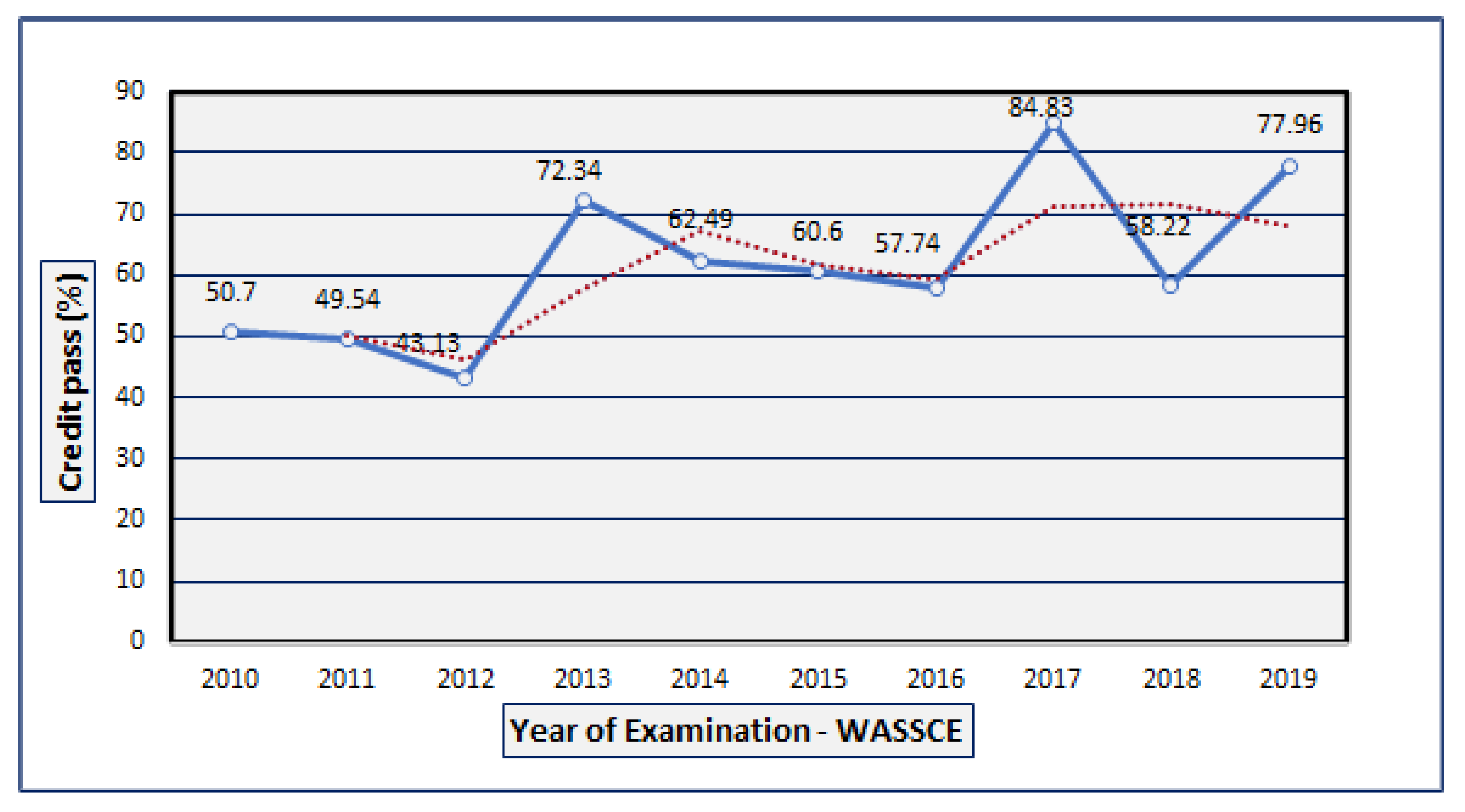


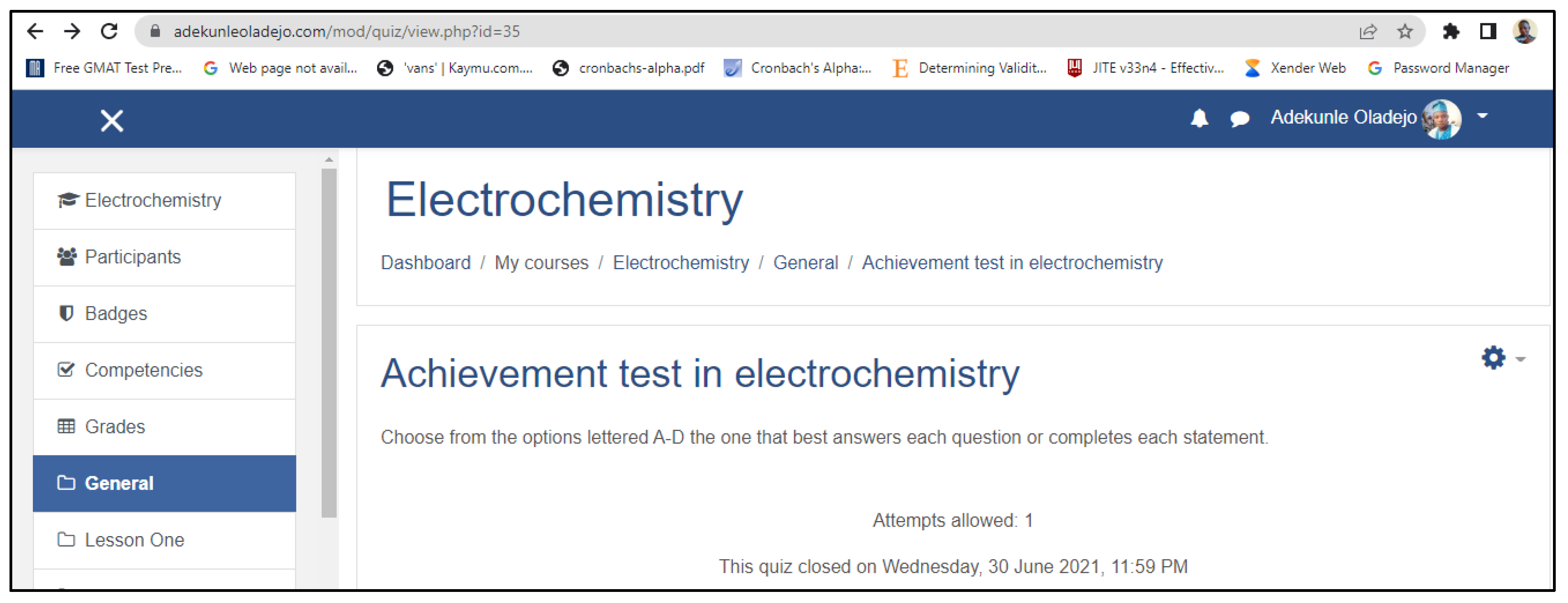

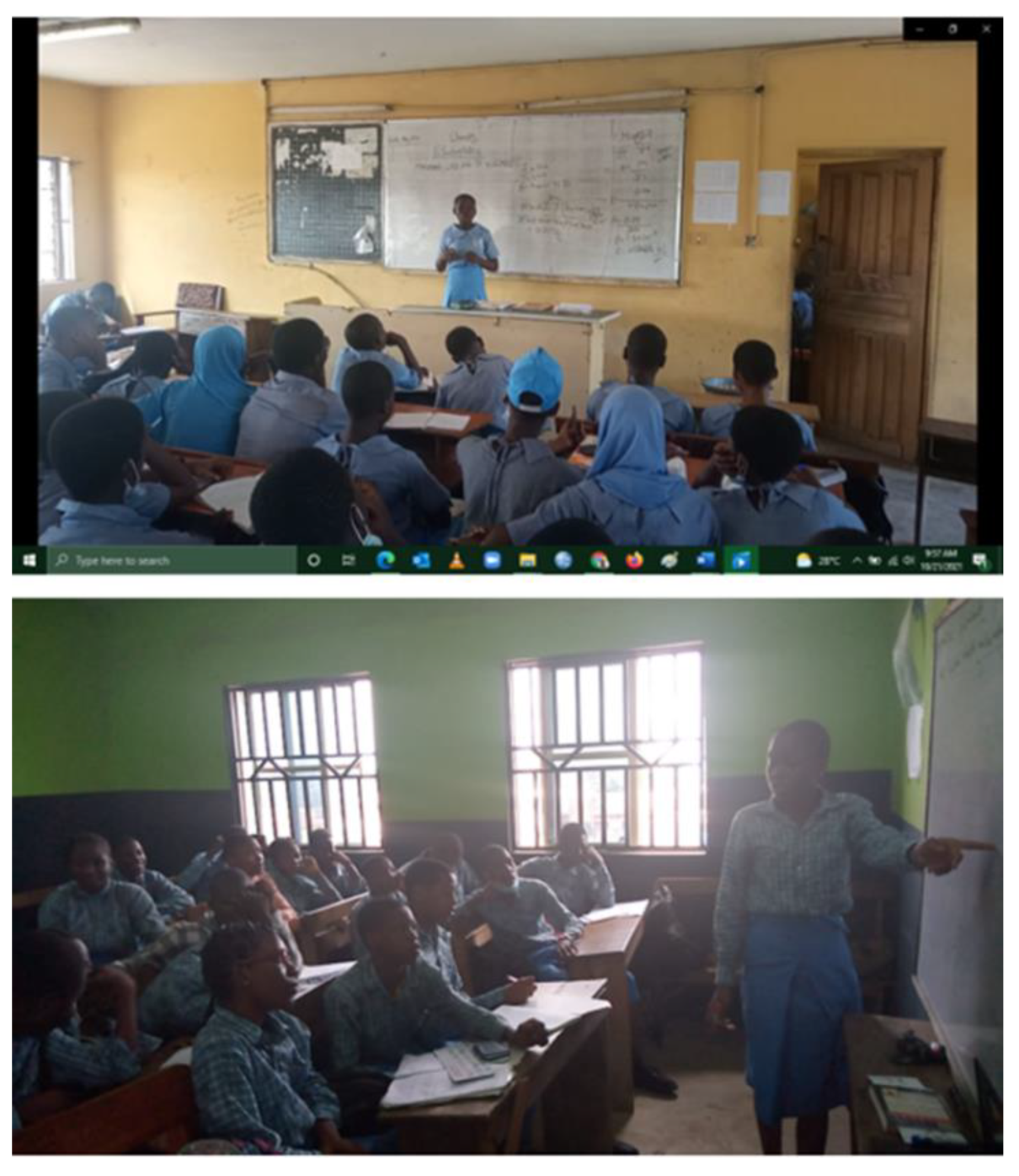


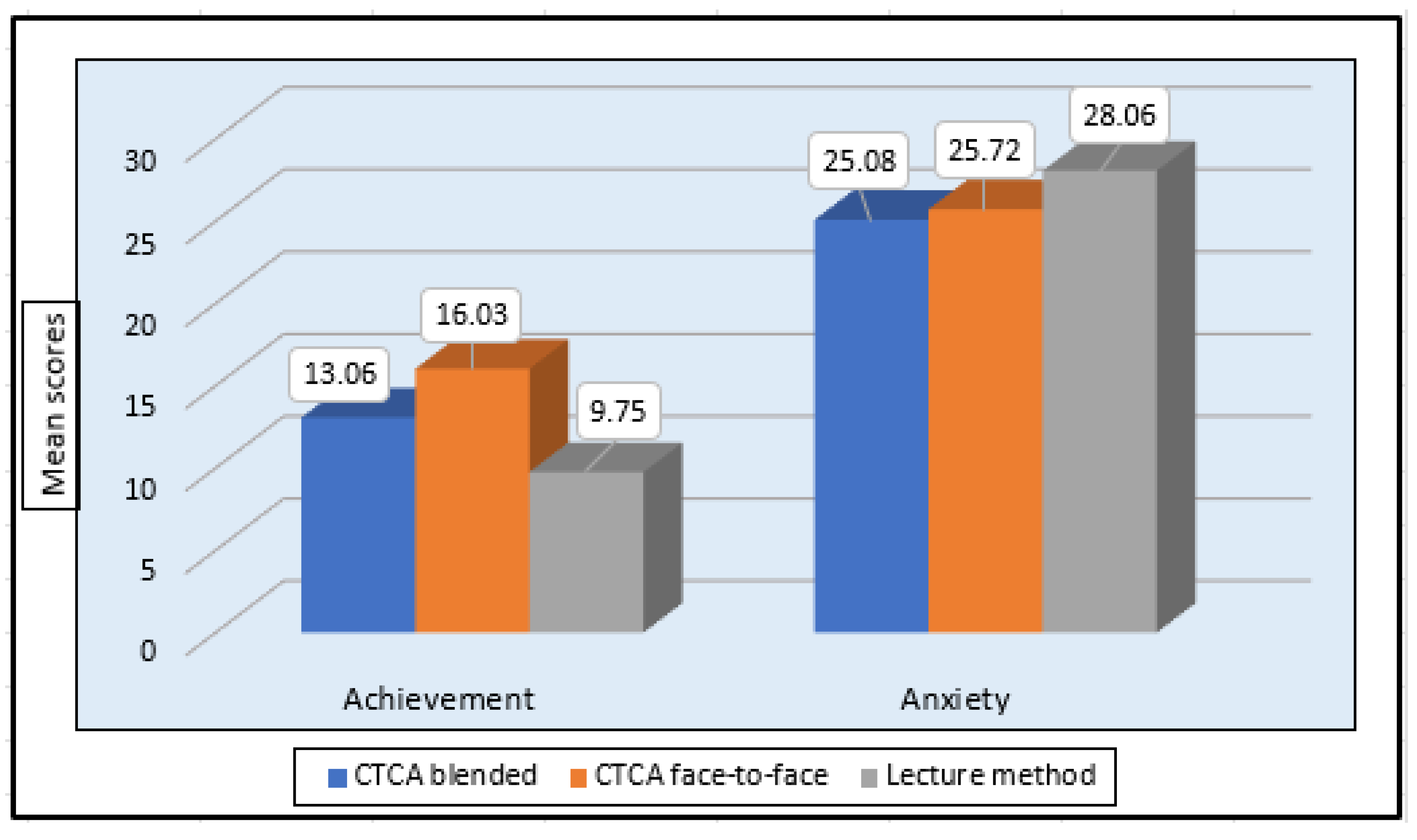

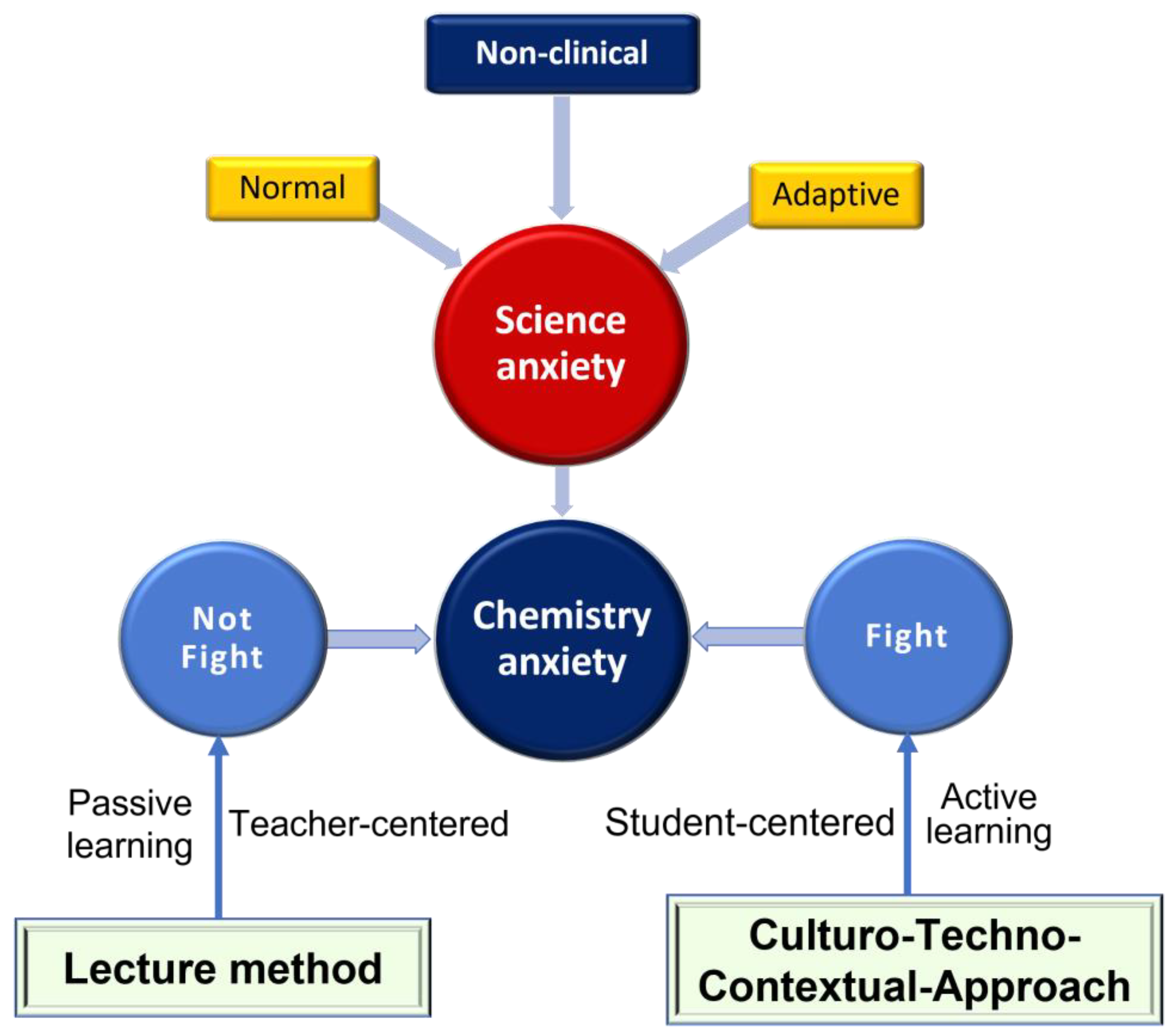
| Dependent Variable | Teaching Strategy | Shapiro-Wilk | ||
|---|---|---|---|---|
| Statistic | df | Sig. | ||
| Achievement | CTCA Blended | 0.95 | 39 | 0.07 |
| CTCA Face-to-face | 0.96 | 48 | 0.13 | |
| Lecture method | 0.97 | 54 | 0.22 | |
| Anxiety | CTCA Blended | 0.97 | 39 | 0.27 |
| CTCA Face-to-face | 0.98 | 48 | 0.38 | |
| Lecture method | 0.97 | 54 | 0.18 | |
| Levene’s Test of Equality of Error Variances | F | df1 | df2 | Sig. |
| Achievement | 0.99 | 2 | 138 | 0.37 |
| Anxiety | 2.96 | 2 | 138 | 0.06 |
| Dependent Variable | Sum of Squares | df | Mean Square | F | Sig. | Partial Eta Squared | |
|---|---|---|---|---|---|---|---|
| Achievement | Contrast | 984.68 | 2 | 492.34 | 72.05 | 0.00 | 0.514 |
| Error | 929.28 | 136 | 6.83 | ||||
| Anxiety | Contrast | 237.65 | 2 | 118.83 | 11.87 | 0.00 | 0.149 |
| Error | 1361.57 | 136 | 10.01 | ||||
| Dependent Variable | Sum of Squares | df | Mean Square | F | Sig. | Partial Eta Squared | |
|---|---|---|---|---|---|---|---|
| Achievement | Contrast | 4.99 | 1 | 4.99 | 0.66 | 0.42 | 0.008 |
| Error | 616.35 | 81 | 7.61 | ||||
| Anxiety | Contrast | 26.08 | 1 | 26.08 | 3.33 | 0.07 | 0.040 |
| Error | 633.48 | 81 | 7.82 | ||||
| Theme | Summary of Findings |
|---|---|
| My general view about CTCA | Responses obtained on students’ general view about CTCA suggest that the students enjoyed been taught and learning using the approach. Specifically, all the respondents affirmed the approach was better than the conventional method often used by their teachers. One of the online group students said, “if I have my ways, I will say the method should be used to teach all subjects because it gives you clues to every lesson before coming to class”. |
| Learning from parents and YouTube before the class | Findings revealed that the students considered the search for content (videos) on YouTube and learning from their parents or elders around them as a good way to prepare for the class before the lesson took place. For some of the respondents, watching videos was interesting, so having to learn through it could only be fun. Beyond content knowledge, the social interaction enjoyed by students, particularly between them and their parents, was another unique gain that the interviewee expressed. |
| The most interesting and helpful learning activities | Findings on this theme varied as much as the available options. For some students, the most impactful learning activity was going online to fetch knowledge. Nneka (pseudo name; 15 years; female; online group) gave the following comment: “For me, the online activity is the most helpful and interesting aspect of the approach. The textbooks’ definitions are not as clear as the explanations given in the videos”. For some, it was contextual examples given by the teacher; while for others, the most impactful aspect of the approach was the group discussion. However, it was noted that about half of the interviewees submitted that the impactful aspect of CTCA was having to search for indigenous knowledge and connect it to class content. |
| The group discussions and presentations | Generally, the students’ responses revealed that the group discussion was a worthwhile exercise. They submitted that the discussions afforded them the opportunity to share what they knew and learned from others. Interviewees who were group leaders during lessons admitted that the opportunity to present before the class had helped to build their confidence to talk before an audience without being shy. Twelve out of the eighteen students interviewed said that this exercise was their first attempt to make a presentation before classmates and a teacher. Perhaps this was the reason some students considered the group discussions as the most interesting and impactful activity. |
| Impact of humor and contextual examples on students’ achievement | “All work and no play make Jack a dull boy” said, Nneka. Olayinka (pseudo name) also said “the jokes keeps the class lively, and it is the one thing that kept me in the class”. He furthered that “even if you have forgotten what was taught, remembering the jokes will help you remember the topic”. All the interviewees submitted that the jokes told by the teacher made the classes interesting and that the use of examples that they can see around their schools and homes made the topics much easier to understand and remember. When asked why, the most recurring answer was that it affords them the opportunity to relate what they have learned in class to the world around them. Some direct quotes will be highlighted in the discussion section. |
| Effect of summary of lessons on learning | The summary of lessons often shared before the next class was reported to have served the following purposes: it helped the students to do a quick revision of what was learnt; for students who don’t like long notes, it was a preferred substitute; it gave those who missed any lesson a hope to get an overview of what was learned; students who were at one time summarised and shared a lesson summary wore a sense of responsibility; and it was the most interesting aspect of the classes for some. Nasir (pseudo name; 15 years; male; face-to-face group) said that “the summary of lesson helps you to get some better understanding of what was learned in class. Even for those who were in class, when you see the summary, you kind of remember what you have learned before”. |
Disclaimer/Publisher’s Note: The statements, opinions and data contained in all publications are solely those of the individual author(s) and contributor(s) and not of MDPI and/or the editor(s). MDPI and/or the editor(s) disclaim responsibility for any injury to people or property resulting from any ideas, methods, instructions or products referred to in the content. |
© 2023 by the authors. Licensee MDPI, Basel, Switzerland. This article is an open access article distributed under the terms and conditions of the Creative Commons Attribution (CC BY) license (https://creativecommons.org/licenses/by/4.0/).
Share and Cite
Oladejo, A.I.; Okebukola, P.A.; Nwaboku, N.; Kola-Olusanya, A.; Olateju, T.T.; Akinola, V.O.; Shabani, J.; Ogunlade, I. Face-to-Face and Blended: Two Pedagogical Conditions for Testing the Efficacy of the Culturo-Techno-Contextual Approach on Learning Anxiety and Achievement in Chemistry. Educ. Sci. 2023, 13, 447. https://doi.org/10.3390/educsci13050447
Oladejo AI, Okebukola PA, Nwaboku N, Kola-Olusanya A, Olateju TT, Akinola VO, Shabani J, Ogunlade I. Face-to-Face and Blended: Two Pedagogical Conditions for Testing the Efficacy of the Culturo-Techno-Contextual Approach on Learning Anxiety and Achievement in Chemistry. Education Sciences. 2023; 13(5):447. https://doi.org/10.3390/educsci13050447
Chicago/Turabian StyleOladejo, Adekunle I., Peter A. Okebukola, Nwabuno Nwaboku, Anthony Kola-Olusanya, Taibat T. Olateju, Victor O. Akinola, Juma Shabani, and Ibiyinka Ogunlade. 2023. "Face-to-Face and Blended: Two Pedagogical Conditions for Testing the Efficacy of the Culturo-Techno-Contextual Approach on Learning Anxiety and Achievement in Chemistry" Education Sciences 13, no. 5: 447. https://doi.org/10.3390/educsci13050447
APA StyleOladejo, A. I., Okebukola, P. A., Nwaboku, N., Kola-Olusanya, A., Olateju, T. T., Akinola, V. O., Shabani, J., & Ogunlade, I. (2023). Face-to-Face and Blended: Two Pedagogical Conditions for Testing the Efficacy of the Culturo-Techno-Contextual Approach on Learning Anxiety and Achievement in Chemistry. Education Sciences, 13(5), 447. https://doi.org/10.3390/educsci13050447






